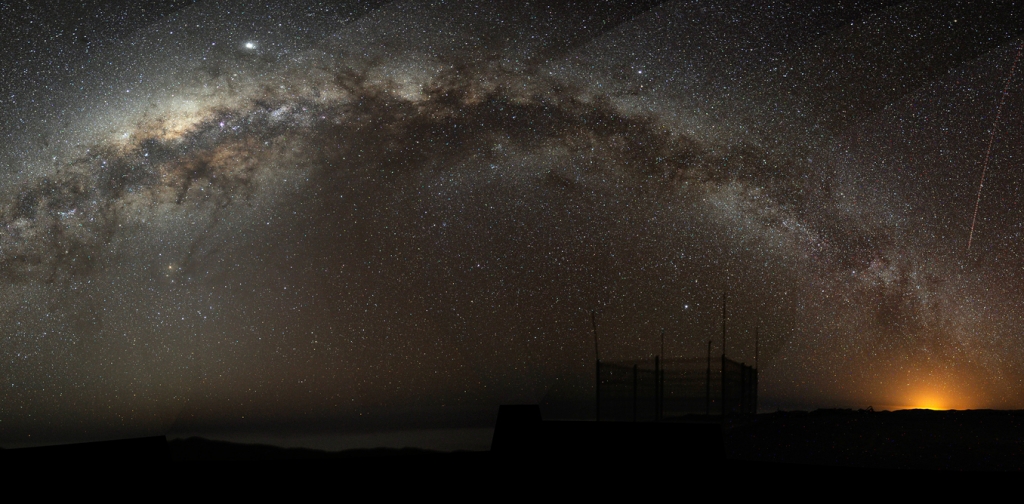One of the most fundamental questions in modern astrophysics is how galaxies first formed. The Milky Way, the galaxy we live in, is an amalgamation of about 100 billion stars, gas, dust and enigmatic dark matter – all held together by gravity. The Milky Way itself is but one of many hundreds of billions of galaxies in the observable universe, with a wide range of sizes, masses, shapes and colours.
We are just beginning to understand how such different kinds of galaxies could arise and evolve. But the picture is blurry. For example, cosmological models of galaxy formation haven’t been able to establish exactly where the stars we see today were first born. Figuring out how galaxies came to be is hugely important. Without them, there would be no stars – and therefore no life in the universe.
Now we have made a discovery, published in the Monthly Notices of the Royal Astronomical Society, that sheds new light on how galaxies and stars within them form.
Enigmatic globular clusters
Astronomers know that some of the Milky Way’s stars were born in the galaxy itself, whereas others were formed in smaller galaxies that the Milky Way eventually engulfed. But it is unclear which process is most common.
Infant stars are born in large groups – never in isolation. Some of these groups, called clusters, are still around today. They roughly come in two types: young, low-mass clusters that live in the Milky Way disk, and massive, old “globular clusters” which are located in the “stellar halo” of the Milky Way (a very large, thin, diaphanous structure) which envelops the disk of the Milky Way. Globular clusters contain a tiny fraction of all Milky Way stars, but astronomers suspect that they hold important clues to the early stages of how the galaxy formed.

Image of the disk and halo of the Milky Way by COBE in infrared. NASA
But we don’t really know how globular clusters formed either. Current models propose that most globular clusters formed in giant molecular clouds within turbulent disks in the early universe. They suggest that globular clusters host multiple generations of stars – stars born from material of other stars, some of which are now dead. However, these models cannot reproduce in detail what we actually observe in globular clusters.
What we know is that the universe only assembled the conditions to form lots of globular clusters in its youth. Ironically, these turbulent disks were also hostile to globular clusters – it is thought that most of them were wiped out by collisions with giant molecular clouds shortly after being born. Those that survived (there are about 150 in the Milky Way) may have lost a substantial fraction of their stars, perhaps even most of them. But if that’s the case, then there should be plenty of stars originally formed in globular clusters now residing in other parts of the galaxy.
The answer could be written in the stars themselves. Their locations, velocities and chemical compositions may hold clues to whether these stars were formed in the Milky Way or elsewhere. All the chemical elements in the universe, except for hydrogen, helium, and tiny amounts of lithium, were synthesised entirely in the interior of stars. When stars die, they shed their nucleosynthetic byproducts into the interstellar medium, out of which new stars are born. Thus, a stars’s chemical composition bears the signature of the evolution of its predecessors. So if we can work that out, it may be possible to establish a star’s origin.
The galaxy has many many stars, though, so to obtain meaningful answers, one needs very large samples. Thanks to recent technological developments, huge surveys currently collect data for hundreds of thousands to millions of Milky Way stars. One of them is the Apache Point Observatory Galactic Evolution Experiment (APOGEE). It stands out from the crowd because of its focus on infrared spectroscopy – a lower frequency of light than that we can see – as opposed to all other surveys that concentrate in the visible part of the spectrum.
This is important because of all the dust in the disk of the Milky Way. Dust is a lot less opaque in the infrared, so APOGEE can see through the dust into the inner regions of the Milky Way much better than optical surveys. This enabled us to estimate the abundances of some key elements for thousands of stars for the first time. We were also able to detect trace stellar families that would otherwise pass unnoticed amid a crowd of ordinary stars.
Peculiar stars
In this way, we discovered a population of stars with unusual chemical compositions, very enriched in nitrogen. This is interesting because it is typical of globular cluster stars. The properties of these new stars differ from those of existing globular clusters, suggesting that they were associated with clusters that no longer exist. The logical implication is that there once existed a very large population of globular clusters in the early Milky Way, which was almost entirely destroyed. Moreover, the properties of the new stars suggest that they are associated with the halo of the Milky Way, not its disk. That being the case, destroyed globular clusters may be the stuff that at least a quarter of the halo is made of.

The Messier 80 globular cluster in the constellation Scorpius. NASA
If confirmed, this result will challenge models of galaxy formation. For instance, APOGEE’s result can constrain which fraction of the halo was formed in the galaxy. It also forces us to revise models of globular cluster formation, which have a hard time explaining the amount of nitrogen that we observe in these stars.
But perhaps a more far-reaching implication is that we might discover that globular clusters are in fact one of the the most typical star-forming units in the universe. In the past two decades, research has made it possible to estimate the mean chemical composition of stars in the cores of distant, unresolved elliptical galaxies, which are thought to be formed in similar ways to the Milky Way halo. Interestingly, this has shown that stars in those galaxies tend to be enriched in nitrogen and sodium, which is precisely what is found in globular clusters.
Indeed, globular clusters may have contributed substantially to the stellar budget of all galaxies in the universe – something we didn’t know before. This is a riveting prospect which could even come to change our understanding of how galaxies came about, including our own Milky Way.
 Ricardo Schiavon receives funding from STFC.
Ricardo Schiavon receives funding from STFC.
This article was originally published on The Conversation. Read the original article.



 How do airplanes fly? An aerospace engineer explains the physics of flight
How do airplanes fly? An aerospace engineer explains the physics of flight  Orbital resonance − the striking gravitational dance done by planets with aligning orbits
Orbital resonance − the striking gravitational dance done by planets with aligning orbits  The mystery of consciousness shows there may be a limit to what science alone can achieve
The mystery of consciousness shows there may be a limit to what science alone can achieve  Black hole, neutron star or something new? We discovered an object that defies explanation
Black hole, neutron star or something new? We discovered an object that defies explanation  Alpha, beta, theta: what are brain states and brain waves? And can we control them?
Alpha, beta, theta: what are brain states and brain waves? And can we control them?  Eggs from men, sperm from women: how stem cell science may change how we reproduce
Eggs from men, sperm from women: how stem cell science may change how we reproduce  Archeoastronomy uses the rare times and places of previous total solar eclipses to help us measure history
Archeoastronomy uses the rare times and places of previous total solar eclipses to help us measure history  The brightest object in the universe is a black hole that eats a star a day
The brightest object in the universe is a black hole that eats a star a day  Tatahouine: 'Star Wars meteorite' sheds light on the early Solar System
Tatahouine: 'Star Wars meteorite' sheds light on the early Solar System  The rising flood of space junk is a risk to us on Earth – and governments are on the hook
The rising flood of space junk is a risk to us on Earth – and governments are on the hook  Dark energy is one of the biggest puzzles in science and we're now a step closer to understanding it
Dark energy is one of the biggest puzzles in science and we're now a step closer to understanding it  If life exists on Jupiter’s moon Europa, scientists might soon be able to detect it
If life exists on Jupiter’s moon Europa, scientists might soon be able to detect it  What is minoxidil, the anti-balding hair growth treatment? Here’s what the science says
What is minoxidil, the anti-balding hair growth treatment? Here’s what the science says  Spacesuits need a major upgrade for the next phase of exploration
Spacesuits need a major upgrade for the next phase of exploration  Could a telescope ever see the beginning of time? An astronomer explains
Could a telescope ever see the beginning of time? An astronomer explains 

































